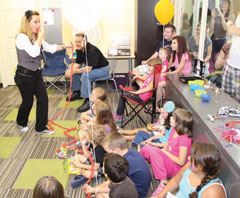Are you not seeing as many patients you’d like? Many practices aren’t. These same practices are feeling the squeeze of reduced reimbursements. What many optometrists may not realize is that there is a steady stream of potential patients already in your office: the kids that tag along with mom, dad, grandma or granddad.
While some practitioners think that pediatric service is not a profitable niche in optometry, many doctors (like us) have found the opposite to be true. Here’s how you can analyze your practice to determine if adding pediatric care is right for you.
‘A Crying Need’
There are four main reasons why optometrists are now expanding their pediatric care, either within their existing office or by opening a second office:
- Medical reimbursements and retail revenue are largely declining.
- Increased competition requires optometrists to do more to stand out from the crowd.
- The inclusion of the pediatric vision benefit of the Affordable Care Act has drawn a lot of attention to children’s eye care.
- There are simply more kids due to a “baby boomlet” that occurred in the late 2000s.
As Mary Lou French, OD, of Children’s Eyecare in Orland Park, Ill., puts it, “There is a crying need, in my opinion, for pediatric eye care, which I am afraid a lot of our colleagues do not address.”
To respond to that need, follow this a five-step lesson plan to help you to strengthen your practice with pediatric eye care services.
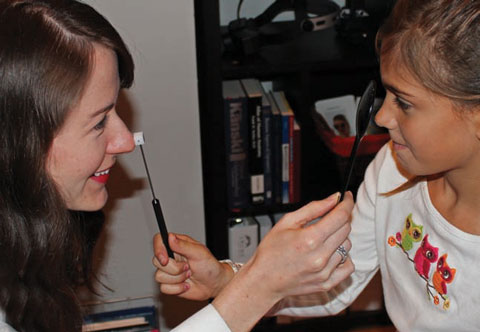 |
| For pediatric exams, turn tests into games, says Stephanie Lyons, OD. Kids make up half of the patient base at her Chicago-area practice. |
Step 1:
Decide Whether Pediatric Care is Right for Your Practice
Many factors come into play for a successful pediatric practice. Most obviously, there must be children. Look around the neighborhood for pediatricians, day care centers, karate studios and other businesses that cater to kids. If so, there are parents in your area who want the best for their kids, and that includes eye care. Unless a large number of practices already cater to kids in your area, this demographic is almost certainly underserved.
It’s not necessary to have specific academic training to expand into pediatric vision care. Katherine Schuetz, OD, of Carmel, Ind., did not complete a pediatric residency, but she did have an affinity for kids and attended lectures and read journals. She and her partner, Jeremy Ciano, OD, noticed many pediatric dentists in their area, but no pediatric eye care. So they opened Little Eyes, a purely pediatric satellite office of their Revolution Eyes practice.
Before you do the same, decide if you or your associate doctors enjoy the company of children. If not, hire someone who does before you proceed. The same goes for staff. Optometric care of kids is easy and fun if the patient is relaxed and comfortable; otherwise, it becomes very difficult to get useful clinical data from them.
Dr. Schuetz recommends that the entire office needs to be committed to the same vision early on. If half of the staff disagrees about how to implement the new pediatric focus, there will be problems. Before launching the pediatric service, have full staff meetings so that everyone from the senior doctor to the newest tech understands this new and important direction for the practice.
Practice consultant Gary Gerber, OD, puts it this way, “We have many clients who have been financially successful with pediatric practices. What they all have in common is that none of them are dabblers. They have a singular focus on growing that segment of their practice. That sense of purpose and consistent work towards concrete goals are the reason they are doing so well.”
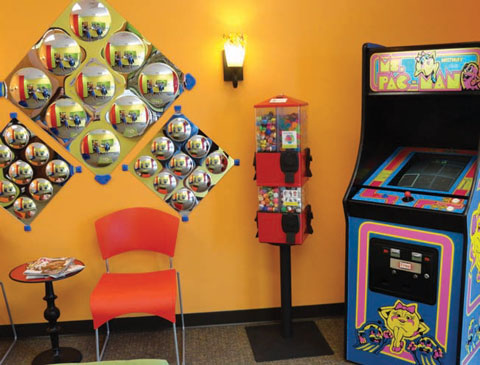 |
| Create a separate waiting area for kids, but make it comfortable and appealing for adults also, as in the Little Eyes satellite office of Katherine Schuetz, OD, and Jeremy Clano, OD, of Carmel, Ind. (Classic arcade games are optional.) |
You must also alter your office environment. Ideally, you should create a separate waiting area with colorful, kid-size furniture and toys, such as a LEGO table or coloring books, to keep little ones occupied and away from delicate frames. Make this part of the practice look kid-friendly and colorful, but be sure it’s comfortable for adults, as well. You want it to be consistent with your overall decor of the practice, and not necessarily look like The Wiggles work there.
Importantly, you’ll need to decide if the influx of younger patients will affect the mix of third-party plans you accept. If you take primarily medical plans, many of these plans will not cover specialty services and you’ll have to explain this to parents. If you don’t take medical plans, you may need to accept lower-reimbursing vision plans to attract families.
Additionally, much has been made about the pediatric vision benefit of the Affordable Care Act, which took effect January 1, 2014. We haven’t yet seen children flood into our offices because of this benefit, but we’re ready for them if they do.
|
How We Built a Purely Pediatric PracticeBy Nathan Bonilla-Warford, OD, and Beth Knighton, OD My primary practice, Bright Eyes Family Vision Care, is about 40% pediatric. My associate, Beth Knighton, OD, and I both have completed residencies in pediatric vision and we see infants and children, including those with developmental disabilities and traumatic brain injury. Over the years, with virtually no external marketing, we grew our vision therapy practice to capacity. We wanted to expand, and decided to build a purely pediatric practice from scratch called Bright Eyes Kids.
Opened in mid-March 2014, Bright Eyes Kids centers on specialty services for children, including vision therapy and ortho-k. This new office is located 17 miles away from our original office, and is closer to main highways for the convenience of our therapy patients who may travel one hour or more for regular therapy sessions. There are few vision therapy optometrists in our area, so easy access from the highway will make therapy more feasible for a lot of patients. At Bright Eyes Kids, we have one exam room, two vision therapy rooms, a doctor’s office, an optical area and a separate waiting area that we share with a music teacher in the same building. The optical has a large selection of pediatric frames, from infant to teen sizes, although we don’t expect it to be a major profit center (besides covering the cost of optical staff). We have kid-created artwork on the walls as well as other cute glasses-related art (from http://eyepowerkidswear.com). In the waiting area, we have kid-themed reading material, such as American Girl and Disney magazines, a LEGO play table and coloring activity center. We’ve received a good response from the limited advertising we’ve placed in local parenting magazines. We also send info to potential referral partners, such as occupational therapists and educational specialists. Additionally, we’ve been visiting local optometrists, pediatric ophthalmologists and pediatricians to see how our services can be helpful to them. We started off seeing one to two patients a day and now we’re seeing eight to 10, including vision therapy sessions. We’re serving an important patient population, building up our practice and having fun doing it. |
Step 2:
Provide Primary Pediatric Care
If you decide to expand your pediatric care, primary eye care is a good place to start. While every optometrist has completed pediatric training, it’s a good idea to review some basics. Start with the AOA Optometric Clinical Practice Guidelines, specifically the guidelines on pediatric care, amblyopia and accommodative and vergence disorders.
Modify your exam based on the age of patient. Children older than eight are examined essentially as adults, just with a special emphasis on the nearpoint visual skills needed for reading and writing in school.
Some equipment you’ll need for the pediatric eye exam:
- Retinoscope and direct ophthalmoscope.
- Digital acuity chart that uses pediatric symbols and is capable of playing videos to hold their attention.
- Lang stereocards.
- Color Vision Testing Made Easy.
- Teller acuity cards or LEA grating paddles, Cardiff cards, LEA symbols or broken wheel cards.
- Toys, puppets and lights to use as fixation targets.
- Dilation spray or drops that can be applied with eyes closed to minimize patient anxiety.
What do you not want in the exam room? A white clinic coat. Kids tend to associate white coats with specialists, shots and other unpleasant things. Even pediatricians don’t wear white coats. Also, move fragile items out of reach, and take down or hide medical educational material that might be too graphic or “gross.”
Put kiddos at ease by starting off with jokes and questions about their favorite toys and movies. If you’re a parent of little tykes, mine them for material and basic knowledge of what’s popular at the moment.
The younger the patient is, the more you have to entertain and play with them, and even sing to them to keep their attention. Don’t get too bogged down getting every measurement precise; keep moving and come back to a particular test if you need to complete the exam.
“We often describe the testing we perform on kids as games,” says optometrist Stephanie Lyons, whose Chicago-based practice is 50% pediatric. Such games can be as simple as doing a high five every time the child gets a line correct on the acuity chart. Use toys for fixation targets that they “catch” by looking at. Turn Wirt circles into a whack-a-mole game; have the child press down—or “whack”—the circles as they pop up.
Optometrists who’ve never performed an infant or toddler eye exam are usually more afraid than the patient. Remember that you’re looking for problems that will interfere with visual development. See how they respond to toys, momentary occlusion and light. Use preferential looking, retinoscopy, cover test and similar tests to quickly pick up on any problems.
Step 3:
Stock Kids Glasses and Contacts
Pediatric frames and lenses are not as profitable as high-end adult frames, but they can be a moneymaker. And these are not the plain frames that were available when you were a kid. They are fashionable, look like adult frames and some are nearly indestructible.
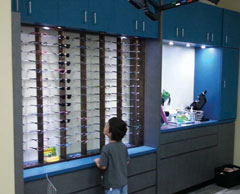 |
| As attitudes about wearing glasses have evolved, so have lenses and frames. Although the parent will have the final call, kids now have many stylish options. |
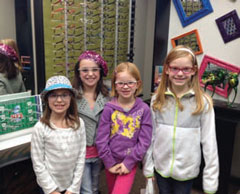 |
Kids are much more likely to accept glasses if they feel like they are part of the decision-making process. For instance, ask the child what their favorite color is and then have the parent pick two or three appropriately colored frames that suit their needs. Fortunately, glasses are extremely popular right now among children of all ages; picking out glasses for kids has never been more fun. Of course, their age and size will dictate the dimension and style of the frame, so have lines for all ages. (See “Children’s Optical: Little Tykes, Large Opportunity,” September 2013.)
Don’t forget the important elements: polycarbonate or Trivex lens materials for safety, scratch protection and UV protection. When offered, many children choose photochromic lenses to reduce sensitivity to bright sun. Others prefer separate sunglasses with greater frame wrap and style. Also offer additional options that children may need, such as sports eyewear and prescription swim goggles.
As with frames, contact lenses have changed dramatically; they are safer, more convenient and cover more prescriptions than ever. While we used to think that children shouldn’t use contacts until their teenage years, the CLIP study has shown that children as young as eight years old tolerate contacts well.1 Older kids want contacts for activities such as sports, but contacts are important for any age in cases of high anisometropia.
For kids’ contacts, patient motivation is absolutely key. If the parent wants contacts more than the child does, there is a poor chance of success. Demonstrating the comfort and handling of today’s daily disposable contacts is easy to do in the exam chair, and will help make the child less apprehensive. Having the patient practice controlling blink reflex and handling the eyelids at home prior to the initial dispense helps greatly.
Step 4:
Consider Specialty Pediatric Services
Any optometrist who sees many pediatric patients will encounter children with special needs, such as those with Down syndrome or autism spectrum disorders. Over time, you’ll develop a comfort level but, in the beginning, by doing as much of the exam as possible and taking into account each patient’s individual needs and challenges, you can help a great many of them, even without special training. Simply prescribing a lens that benefits them, such as bifocals (when indicated), may go a long way in improving their quality of life.
Other patients require additional care in the form of vision therapy to help with visual skills that they either did not develop or lost. While vision therapy can certainly benefit patients of all ages, the majority of vision therapy patients are kids, and it can be a major component of a pediatric practice.
While there are many avenues for post-doctoral training in vision therapy (most notably the College of Vision Development and the Optometric Extension Program Foundation), you can start growing the program with the most common and easily treated cases such as convergence insufficiency and amblyopia, for which there is a wealth of clinical research. As you gain comfort, you can take on more complicated cases, such as strabismus.
It’s true that vision therapy is time consuming, but it is often provided on a fee-for-service basis and can be quite profitable once vision therapists are trained. Additionally, vision therapy patients tend to be the most loyal and the loudest word-of-mouth marketers for your practice. Many doctors maintain a separate practice for vision therapy. Vision therapy does require additional office space, but can be performed in a spare exam room.
Orthokeratology, also called ortho-k or corneal reshaping, is another profitable specialty service that patients will seek out. Ortho-k corrects refractive error in the short term so kids can be active without glasses or contacts. In the long term, it has been shown to reduce myopia progression.2
Myopia is a significant source of concern for many parents and doctors. But our understanding of myopiagenesis has improved greatly and, in addition to ortho-k, bifocal glasses, multifocal soft contacts and low-dose atropine have also been shown to reduce myopia progression.3,4 “I don’t think you can have a pediatric practice without offering some, if not all, of those services,” says Paul Levine, OD, of Vision Care Specialists in Southborough, Mass.
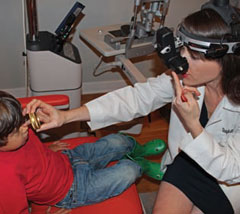 |
| Pediatric vision care is rewarding in more ways than one. "There's no better feeling than watching a child's eyes light up when they put on their first pair of glasses," Dr. Lyons says. |
Also, if you invest in special diagnostic equipment, you’ll not only serve your pediatric patients more effectively, you may also receive referrals for testing from fellow ODs and other professionals. Examples include visual evoked potential for objectively evaluating the vision pathway in cases of amblyopia and glaucoma, the Test of Variables of Attention (TOVA Company) for evaluating visual attention, and the Visagraph (Reading Plus) or ReadAlyzer (Compevo AB) for documenting eye movements.
Step 5:
Get the Word Out
Promoting a pediatric practice or clinic within a larger practice is not much different than your current marketing approach. Start with internal marketing. As you know, many parents mistakenly think that if their kids have passed a school vision screening then they’ll have no problem. So, place signs and literature educating parents about children’s vision. Discuss InfantSee with pregnant patients. Make pediatric care highly visible on your website and include pediatric intake forms for parents to fill out at home.
Finally, don’t forget networking. Drs. Schuetz has had success working with the local schools. Sending a follow-up letter to the pediatrician after a child fails their vision screening is a good way to initiate a relationship. Visit potential referral sources and find out how you can be helpful to them. Leonard Press, OD, of Fair Lawn, NJ, agrees: “If you can establish a working relationship with at least one pediatric ophthalmologist in your area where there is mutual respect, that can be helpful.”
One of the most powerful aspects of expanding a practice into pediatric care is the statement that your practice is different from others. As a specialist, you are dedicated to the most important thing in a parent’s life: their children. This can be very profitable as well as rewarding. “There’s no better feeling than watching a child’s eyes light up when they put on their first pair of glasses or seeing the patient with convergence insufficiency become the most avid reader in his class,” Dr. Lyons says. “Those moments make the daily hassles of working with kids well worth the extra time and effort.”
Dr. Bonilla-Warford is in private practice in Tampa, Fla., specializing in vision therapy and orthokeratology. Dr. Knighton is in private practice in Tampa and Clearwater, Fla., specializing in pediatrics and patients with special needs.
1. Walline JJ, Jones LA, Rah MJ, et al; CLIP Study Group. Contact Lenses in Pediatrics (CLIP) Study: chair time and ocular health. Optom Vis Sci. 2007 Sep;84(9):896-902.
2. Walline JJ, Jones LA, Sinnott LT. Corneal reshaping and myopia progression. Br J Ophthalmol. 2009 Sep;93(9):1181-5.
3. Walline JJ, Lindsley K, Vedula SS, et al. Interventions to slow progression of myopia in children. Cochrane Database Syst Rev. 2011 Dec 7;(12):CD004916.
4. Walline JJ, Greiner KL, McVey ME, Jones-Jordan LA. Multifocal contact lens myopia control. Optom Vis Sci. 2013 Nov;90(11):1207-14.
